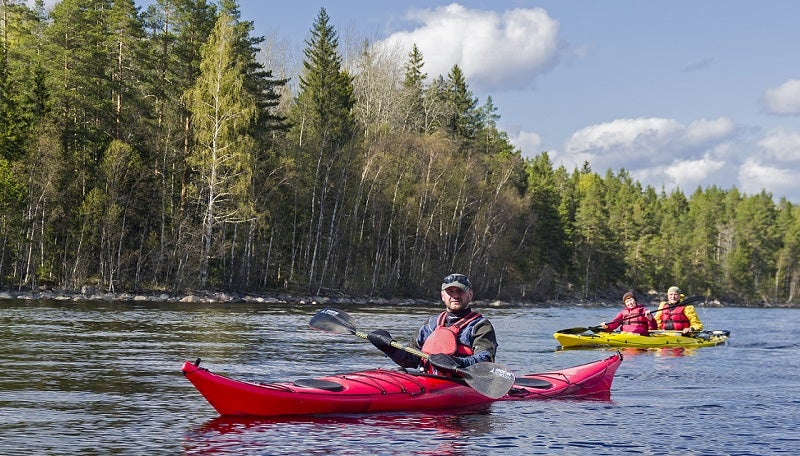
Our Editors independently research, test, and rate what we feel are the best products. We use affiliate links and may receive a small commission on purchases.
For me it was a big step from the family canoe to my first kayak. From there I learned to love spending time on the water and fell in love with the agility and freedom of a kayak.
If you’re like me, it probably didn’t take you long to yearn for more. That’s why you’re here – to learn how to pick out the best touring kayak.
My goal is to help you figure out everything you need to know in order to choose the right touring kayak for you. Together we’ll cover all the details you’ll need to know.
I’ll answer all of your questions and a few you may not have even thought of!
Now, I’m going to make a few suggestions of some top rated touring & sea kayaks you can choose from.
Best Touring & Sea Kayaks
| Eddyline Sitka LT Touring Kayak | Delta Kayaks Delta 17 Touring Kayak | Eddyline Rio Lite Touring Kayak | |
|---|---|---|---|
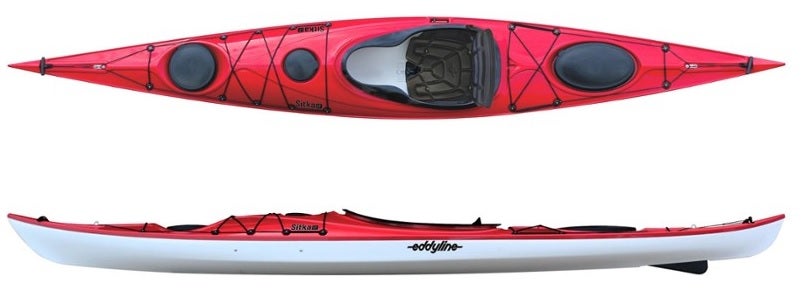 | 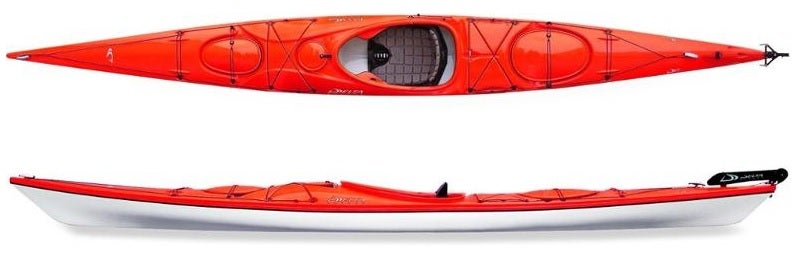 | 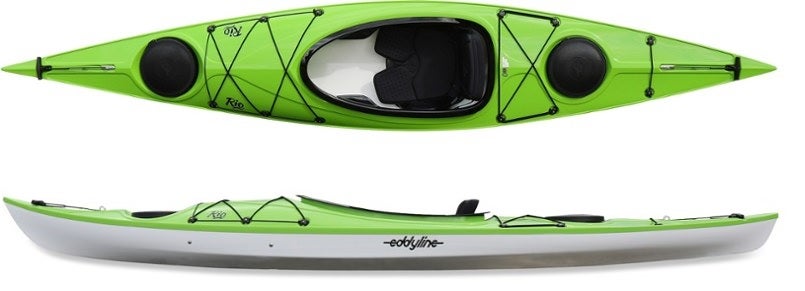 |
|
| Length: | 14 ft, 6 in | 17 Feet | 11 ft, 9 in |
| Width: | 23.5 inches | 22.5 inches | 24” |
| Features: | Retractable skeg, 350 lbs max load | Dual hatches, retractable rudder included, 410lbs maximum load | Two sealed hatches, hard chines |
| REI | REI.com | REI |
For more of my kayak gear recommendations, have a look through these popular Outside Pursuits guide links: Kayak Paddles, Kayak Life Jackets, Kayak Seats.
Quick Answer: The Best Rated Touring Kayaks
- Eddyline Sitka LT Touring Kayak
- Delta Kayaks Delta 17 Touring Kayak
- Eddyline Rio Lite Touring Kayak
- Riot Kayaks Brittany Flatwater Touring Kayak
- Wilderness Systems Tsunami 145 Kayak
Let’s get to it!
Touring Kayak Reviews
#1 Eddyline Sitka LT Touring Kayak
- Length: 14 ft, 6 in
- Width: 23.5 inches
- Features: Retractable skeg, 350 lbs max load
The Eddyline Sitka is in the mid range length for traditional touring kayak coming in at 14.5 feet. The retractable skeg helps with tracking on this boat.
Where this kayak shines is that the cockpit is ergonomic and very comfortable over long distances. The hip and thigh pads give you a performance and comfort edge over most other kayaks in its price range.
Eddyline didn’t skimp on the seat, the “Infinity” seat system allows a wide range of adjustment so that no matter how tall or side you are you should be able to find a comfortable position.
We really liked the three storage bulkheads that give you ample storage plus the deck rigging allows extra gear to be strapped on. The small fore hatch is easily accessible for quick access to frequently used items.
The Carbonlite ABS plastic hull gives this boat good performance and a light weight of only 49 pounds.
Best For: Paddlers looking for the best touring kayak that won’t break the bank.
#2 Delta Kayaks Delta 17 Touring Kayak
- Length: 17 Feet
- Width: 22.5 inches
- Features: Dual hatches, retractable rudder included, 410lbs maximum load
Delta Kayaks makes a ton of great touring kayaks so be sure to check out their full line. This 17’ kayak is made for day or weekend touring trips when a longer kayak is needed.
When you want a bit more agility and some extra storage, the Epsilon is an ideal companion. Made with tons of deck lashing and two ample hatches, there’s room for gear for an overnight or a day trip.
A nice feature is the easily reachable low-profile front day hatch for keeping items you need to quickly access.
Included on the boat is an integrate rudder system which, of course, is easily retractable when not needed. Inside the cockpit is an adjustable seat, foot braces, and thigh braces.
The boat has a pronounced chine which can help rough waters roll off when the waves start to chop. There’s nothing crazy going on here – just a solid touring boat ready for a mix of adventures.
Thanks to the longer size and soft chines on this boat it’s perhaps the best day / weekend boat on our list. Join your friends for a recreational river paddle or head out for a weekend of camping in your own.
Best For: Covering all your bases with one boat.
REI.com#3 Eddyline Rio Lite Touring Kayak
- Length: 11 ft, 9 in
- Width: 24”
- Features: Two sealed hatches, hard chines
Eddyline keeps their lines of kayaks small and focused. They’re a high end manufacturer that creates amazing touring boats but won’t break the bank. This 11’9″ boat is loaded and ready for light day touring and capable of handling some nasty weather!
Perception produces this kayak with a slim cockpit that is well padded and fitted with an adjustable ergonomic seat and thigh pads to lock in your control of the boat while staying comfortable.
They kept the overall cost of the boat affordable by choosing Carbonlite composite ABS/acrylic as the material choice. This keeps the boat very lightweight for easy transport (weighs only 35 lbs).
There are front and rear sealed hatches along with plenty of deck rigging to hold gear.
Overall this boat is in the short end for a touring boat which why they call it a “Lite” touring kayak. It features a low profile for efficiency and the relatively flat, long keel with hard chines that help the boat track well over long distances.
Best For: Paddlers who want to avoid breaking the bank when choosing their touring kayak.
#4 Riot Kayaks Brittany 16.5 Flatwater Touring Kayak
- Length: 16.5 Feet
- Width: 21.75 inches
- Features: Rudder included, retractable skeg, 3 hatches
This British-style sea kayak is ready to hit the water loaded with features. It might be one of the most feature-rich boats on our list. And, it’s miraculously affordable.
Let’s start with the skeg and rudder. Included on this boat is an integrate rudder. The rudder can be retracted for storage, travel, or when you don’t want it.
Also included is a retractable skeg. When in use it stabilizes the boat and can be used with or without the rudder.
I like that this boat features three hatches. Each with a separate compartment it’s one of the biggest storage options of any boat on our list.
There’s also an abundance of deck lashing which provides an additional storage option for those times when you’ve got to haul a load.
Other small features include the custom fit seating which combines with the adjustable foot braces and thigh braces to create a fully fitted ride. There’s also an included reflective lifeline, paddle hook for storing your paddle, and safety straps.
Best For: A larger profile touring kayak with tons of storage and maybe the best sea kayak.
#5 Wilderness Systems Tsunami 145 Kayak
- Length: 14.5 ft
- Width: 25.5 in
- Features: Pedal-controlled rudder, two secured hatches
Touring kayaks are a step away from recreational kayaks. Their goal is typically to have more storage space and a more efficient long distance capacity.
Sometimes we need a kayak that can handle the rougher conditions and the Tsunami is ready to help you take that on.
This generously sized cockpit has some of the comfort of a recreational kayak with some of the features of a touring boat. Integrated thigh braces make it easy to control and brace the boat.
While the large cockpit is much more generous than a standard touring boat. It comes with 2 secure storage wells, adding to storage capability is the rear decking rigging and removable mesh deck storage bags.
Made from polyethylene, this boat is fairly mid-priced sea kayak. With its 14.5 foot length, the boat weighs a reasonable 56 pounds which makes it easily portable for most paddlers.
There’s even an integrate recessed bow compass mount for navigation. Overall the boat has a relatively flat rocker and hard chine which makes it a faster boat.
This boat is mostly a hybrid of touring and sea kayak features at a low price point.
Best For: Paddlers who want a good boat that can handle rougher conditions and flatwater touring.
REI.comTouring Kayak Comparison Table
| Touring Kayak | Length | Width | Features | |
|---|---|---|---|---|
| Eddyline Sitka LT Touring Kayak |  | 14 ft, 6 in | 23.5 inches | Retractable skeg, 350 lbs max load |
| Delta Kayaks Delta 17 Touring Kayak |  | 17 Feet | 22.5 inches | Dual hatches, retractable rudder included, 410lbs maximum load |
| Eddyline Rio Lite Touring Kayak |  | 11 ft, 9 in | 24” | Two sealed hatches, hard chines |
| Riot Kayaks Brittany 16.5 Flatwater Touring Kayak | 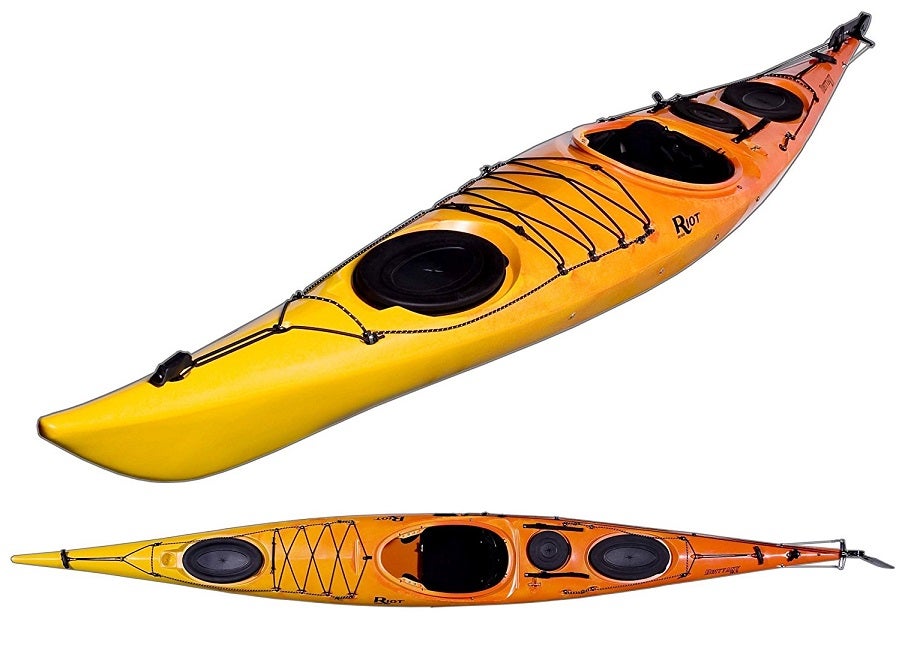 | 16.5 Feet | 21.75 inches | Rudder included, retractable skeg, 3 hatches |
| Wilderness Systems Tsunami 145 Kayak | 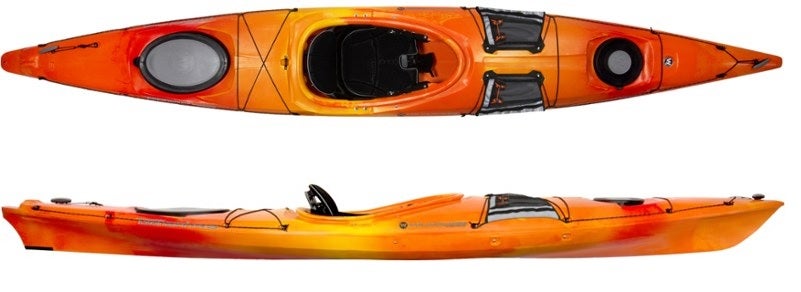 | 14.5 ft | 25.5 in | Pedal-controlled rudder, two secured hatches |
How to Choose the Best Touring Kayak
- Kayak Materials
- Hull Shapes
- Chines
- Primary vs Secondary Stability
- Kayak Rocker
- Kayak Lengths
- FAQs About Touring Kayaks
- Touring Kayak Features
- Conclusion
Choosing the right touring kayak starts with understanding the way that kayaks are created, shaped, and designed.
Once you’ve learned these fundamentals, you’ll be able to look at any touring kayak and know whether or not it’s likely to be a good fit for your needs.
Kayak Materials
There are a handful of synthetic and natural materials from which touring kayaks can be crafted. Each one has its own unique properties and distinct pros and cons. Choose the correct one for your needs, skill level, and budget.
These materials are:
- Polyethylene
- Polycarbonate
- Fiberglass
- Wood
Polyethylene – is one of the most common kayak materials. It is slightly flexible and resists impact well. That means it’s not too likely to crack a hole if you ram it ashore or bounce off a rock.
On the downside is that Polyethylene is quite prone to UV damage over time from sun exposure. This won’t be an issue unless you store the kayak in sunlight or use it a lot.
Polycarbonate – looks and feels a lot like polyethylene but has a few advantages. Polycarbonate can be crafted into a smoother hull which glides more efficiently through water. For a touring kayak this is ideal because it makes long days of paddling easier. Ideal for upgrading efficiency without paying through the nose.
Fiberglass – is a common body working material that you can find at your local hardware. In theory you could cast your own fiberglass kayak relatively easily!
It’s a popular choice because of its durability, light weight, and the ability to retain a very sleek, smooth surface polish. Buying a fiberglass kayak will cost you quite a bit more than a poly boat.
Wood – kayaks are possibly the most rare form of kayak. Like fiberglass canoes they can also be made at home. They’re generally nosebleed expensive because they take tons of time and craftsmanship to create.
Wooden boats can be extremely efficient, durable, and fun to paddle when built well. It’s worth mentioning that carbon fiber can sometimes be found in use for racing kayaks.
Hull Shapes
Hull shapes refer to the shape of the boat if you were to cut it in half and look at it head-on. Each type of hull design is intended to excel in certain characteristics. Not all hulls are created equal and each type has its pros and cons.
V-shaped – hulls are by far the most common and effective on touring kayaks. These hulls form a very sharp V shape under the boat and are not rounded like a U.
They can be squirrelly at first and have poor initial stability. Once under motion they perform efficiently and cut the water like a blade.
Rounded – hulls could be accurately described as U-shaped hulls. They are usually uniformly round or may change angle at some point. However they are much more gently sloped than a V-shaped hull. These boats have poor initial stability but perform well when on edge.
Flat and Tunnel – hulls are the other main designs in use today. These are both ill-suited for touring boats as they’re less efficient and offer better stability when sitting still rather than paddling.
Touring boats will rarely, if ever, feature one of these designs so we won’t go into them.
Chines
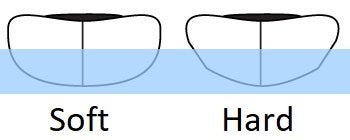
These little kayak features are important to understand. Chines can be described as the physical area where the side of the boat transitions into the bottom of the boat.
Chines can come in many shapes and sizes and some boats even have more than one chine.
Chines are usually described as either soft or hard. A hard chine would be akin to a right angle, while a soft chine would be akin to a rounded corner.
Hard Chines
Hard chined boats have what might appear to be a crease that runs along the length of the boat. A noticeable depression in the material of the boat. Hard chines result in good stability when upright and exceptional speed and tracking.
Hard Chine Advantages:
- Great primary stability
- Speed and straight tracking
Soft Chines
Soft chined boats may have little or no visible “crease” but instead might appear more seamless. Soft chined boats have great stability when tipped on a side (secondary stability).
These boats perform well in rough waters where the waves can simply slide off the rounded chines. They’re not as fast as hard chined boats, however.
Primary vs Secondary Stability
You’ve already heard this mention and probably figured it out by now. Part of choosing the right kayak is knowing what kind of stability you’re in the market for. Depending on many features, a kayak may have primary stability, secondary stability, or a mixture.
Primary stability – refers to how stable a boat is when positioned upright. This also has a great impact on stability when the boat is sitting still, such as when you enter the boat or if you were to be fishing from the boat.
Secondary stability – is a measure of how stable the boat is once it has been tipped. Secondary stability is great for rough seas in open water conditions or for whitewater boats. For most touring boats secondary stability is less important.
Kayak Rocker
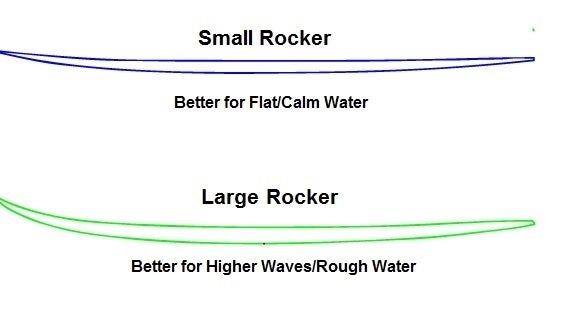 We talked about hull shape which is the shape of the boat from a head-on perspective. Now imagine the kayak from a side perspective. This is where rocker comes into play.
We talked about hull shape which is the shape of the boat from a head-on perspective. Now imagine the kayak from a side perspective. This is where rocker comes into play.
If you’re a skier then you’re already familiar with the term rocker. A rockered boat, or ski, is up turned like a banana. When set flat on the ground both the bow and stern are lifted off the ground in an arch.
Most boats have some amount of rocker. Rocker helps aid in maneuverability because the bow and stern have less material submerged. That way when paddlers input turning forces to the boat, there’s less to resist the turn.
In touring kayaks having less rocker is usually preferable. A flatter touring kayak leaves more of the boat underwater at the bow and stern which aids in tracking straight lines.
When paddling long distances efficiently, we want to minimize the amount of zigzag from paddle input.
Kayak Lengths
While kayaks can span the spectrum from ~5’ to 18’+ touring boats tend to be on the longer side of the spectrum. Why?
Because longer boats have more room for storage. On touring trips you’ll need all the space you can get for fitting in gear, food, and shelter if you’re camping. Storage needs aside, a longer boat also tracks and cuts through the water better.
Like avoiding rocker, having a longer boat aids in the tracking and efficiency of a touring boat. These two factors make a longer boat of 14’-18’+ the norm for touring.
FAQs About Touring & Sea Kayaks
Q: Should I get a single or tandem kayak?
A: Not as common for touring kayaks but if you have a child that you think you may want to take with you then you will have little choice but to get a tandem. If you have a spouse or friend you may be better off with two single kayaks. It saves a lot of disputes! Of course if you just want the extra room or plan on taking along an extra paddler, a tandem may be a better option.
Q: Do I need to wear a PFD?
A: Legally you must have a PFD or life jacket on board at all times. Children are required to wear one at all times. A PFD that is strapped in the back of the kayak will do you little good however if you tip over. Get a inflatable one and wear it at all times. They are light and thin, you will not even notice are wearing it.
Q: Does color of the kayak matter?
A: If you plan on kayak where there are motorized boats around I would recommend bright colors like orange and yellow so you can be more easily seen.
Q: Will I get wet when I am kayaking?
A: Yes! It is inevitable no matter what type of kayak you use. Less so with a sit inside kayak.
Q: Is it worth spending more for a light carbon fiber paddle?
A: Short answer, yes. Your paddle is your engine, the lighter the paddle the easier it is and the less fatiqued you will get.
Q: Is a longer or shorter kayak better?
A: As a general rule of thumb, the longer the kayak the faster it is and the better it tracks, so for touring kayaks generally longer is better.
Touring & Sea Kayak Features
Spray Skirts – are important features of almost all touring kayaks. They keep water from lapping into the boat during rough waters or rainy weather. These are commonly included with touring boats.
Skegs – are a metal or plastic plate which are usually removable. They attach to the keel of the boat and help with tracking and efficiency. These are common on touring boats.
Rudders – are all about directional control. A rudder, when properly used, can help with correcting for wind or paddling error.
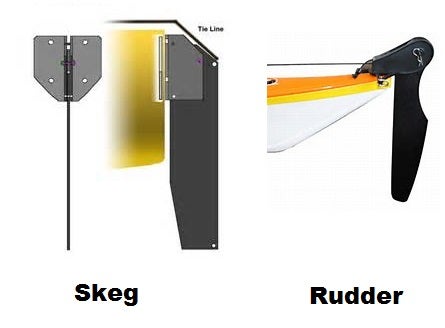
Conclusion
Finding the right touring kayak can take some time. Everyone has a different budget. Plus, the boat you choose depends on whether you want to be out for a day, weekend, or an entire week at a time.
Some of the boats on our list are gender neutral, some are specific. Each boat has a unique set of features that makes it a good choice for some users. Be sure to go back and look over the “how to choose” section to freshen up on touring kayak features.
No matter what boat you choose, we all grow into new preferences and skills with time. Don’t be surprised if some day you find yourself moving to a new touring kayak that fits your developing needs.
For now, just start with where you’re at and make the best choice for you!
How We Researched
To come up with the top sea and touring kayaks we researched a variety of sources for reviews such as REI, Dicks Sporting Goods, Cabelas and Backcountry along with our own personal experience.
We also consulted online magazines for product research and reviews to get as much unbiased information as we could. To help weed out fake reviews we used Fakespot.com to make sure we only looked at genuine reviews.
With so much quality gear available, we had to narrow it down based on what we felt were the best options for the price. The author, Casey Fiedler has been an avid kayaker and leads kayak camping trips during the summer months in his native state of Michigan.
To help narrow down the selection he used his personal experience along with recommendations from kayak tour guides and rental shops.
After extensive research, we came up with our list to help you choose the right one for you.
Sources
I hope this guide was helpful for finding a good touring kayak to fit your needs. If you want to comment or recommend a kayak I didn’t include, please use my contact form to get in touch.
Have fun and be safe out there

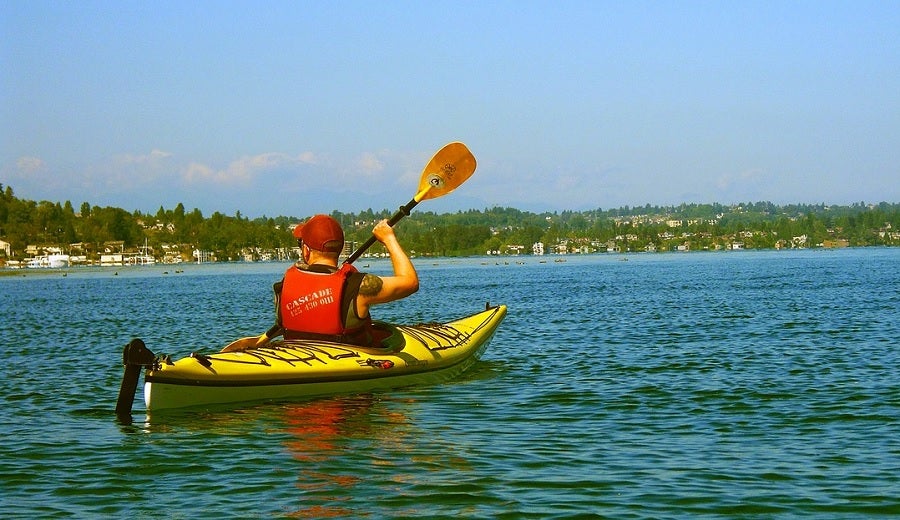
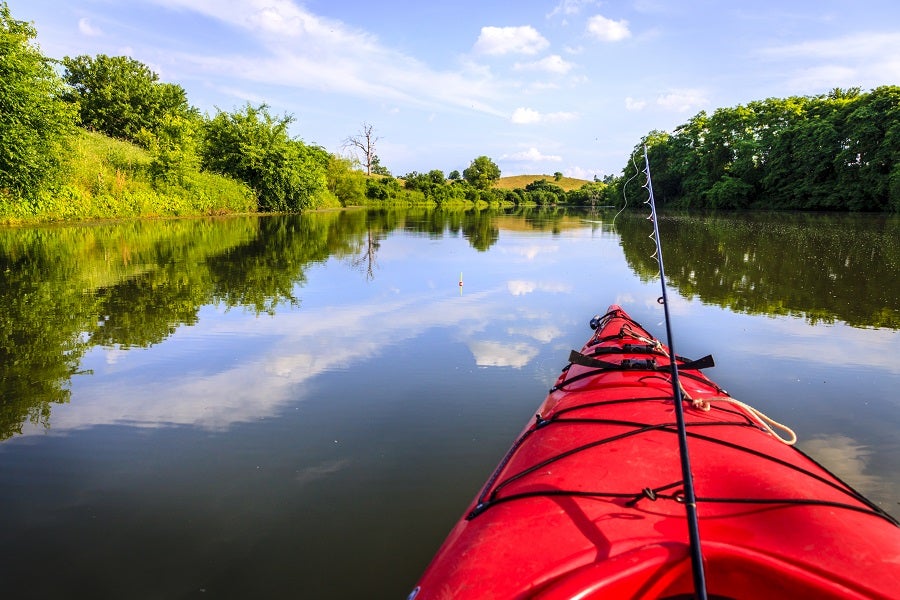
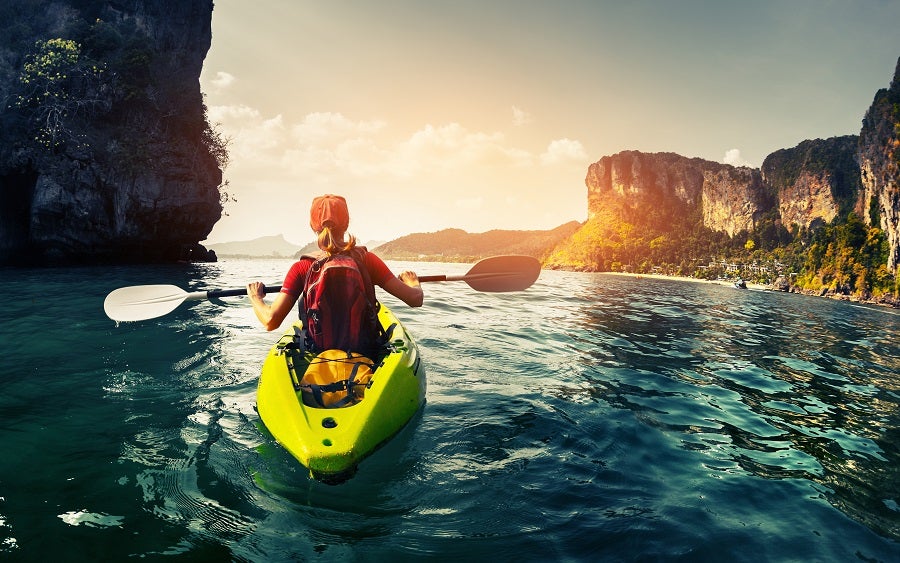
Casey, I think you need to re-think this review. Despite it being updated about 6 weeks ago, none of the kayaks you discuss are built anymore. So not much help!
Jim, When I choose them they were available, unfortunately with the supply chain disruptions manufacturers are finding it hard to keep products in stock.